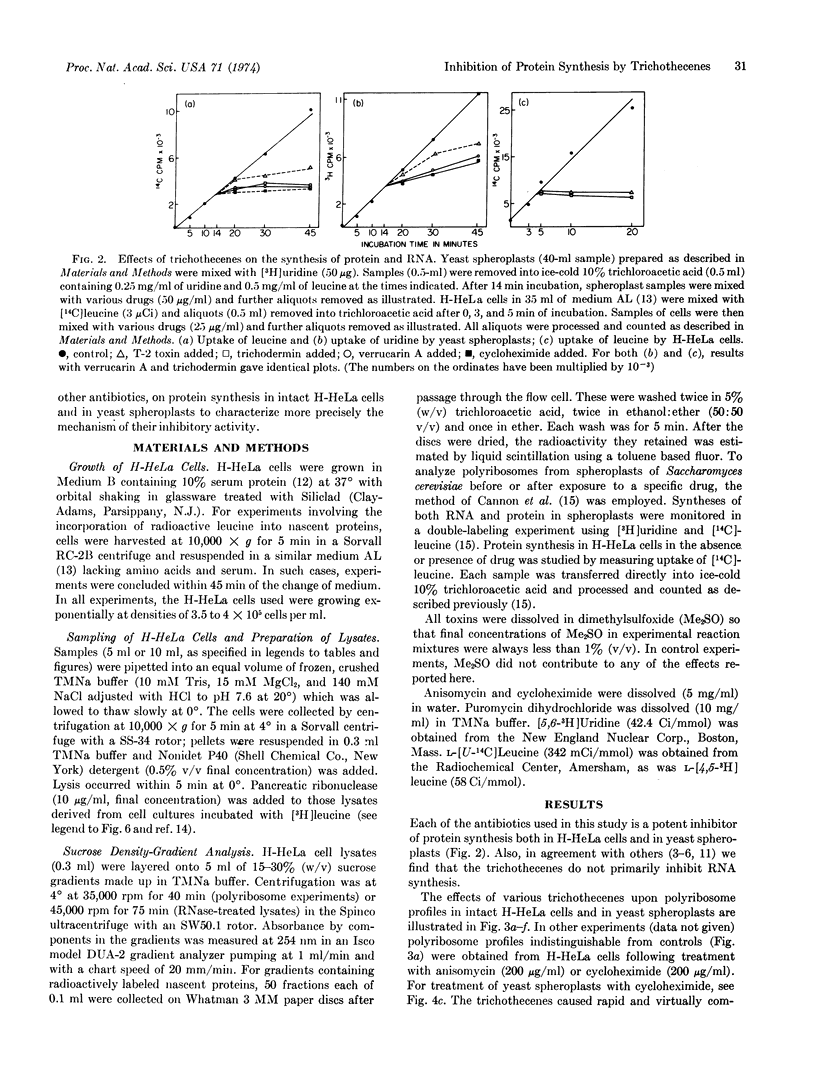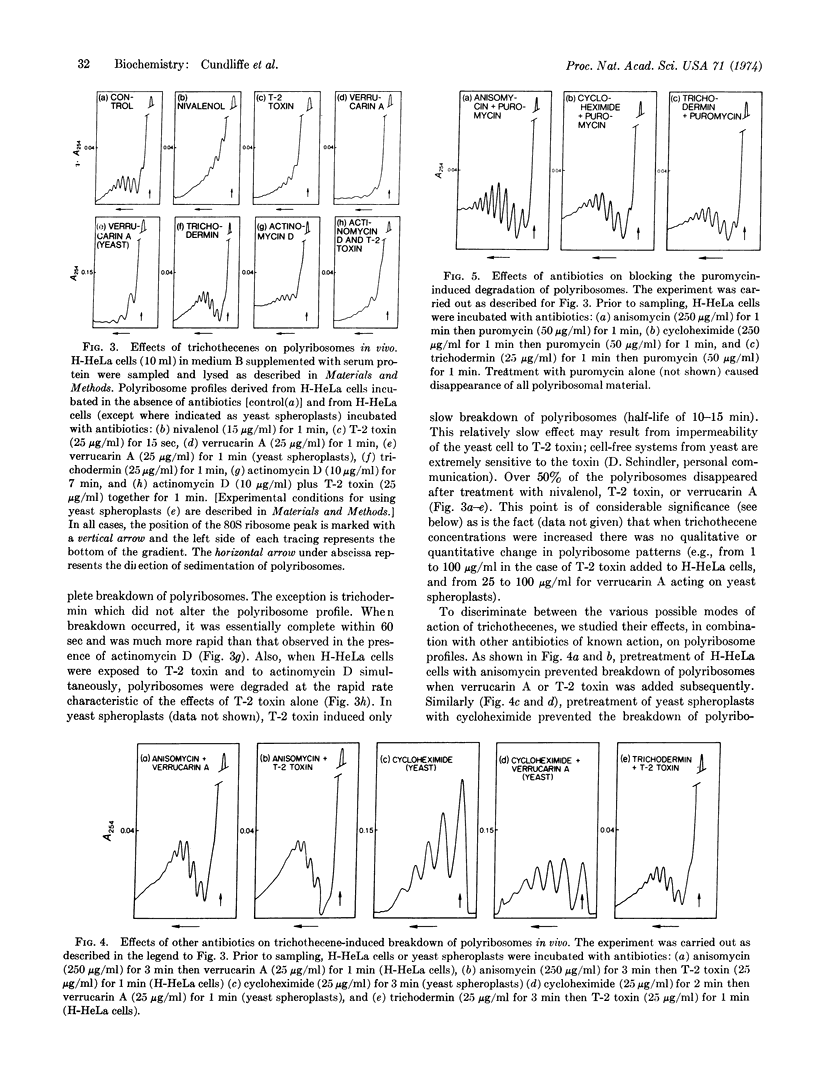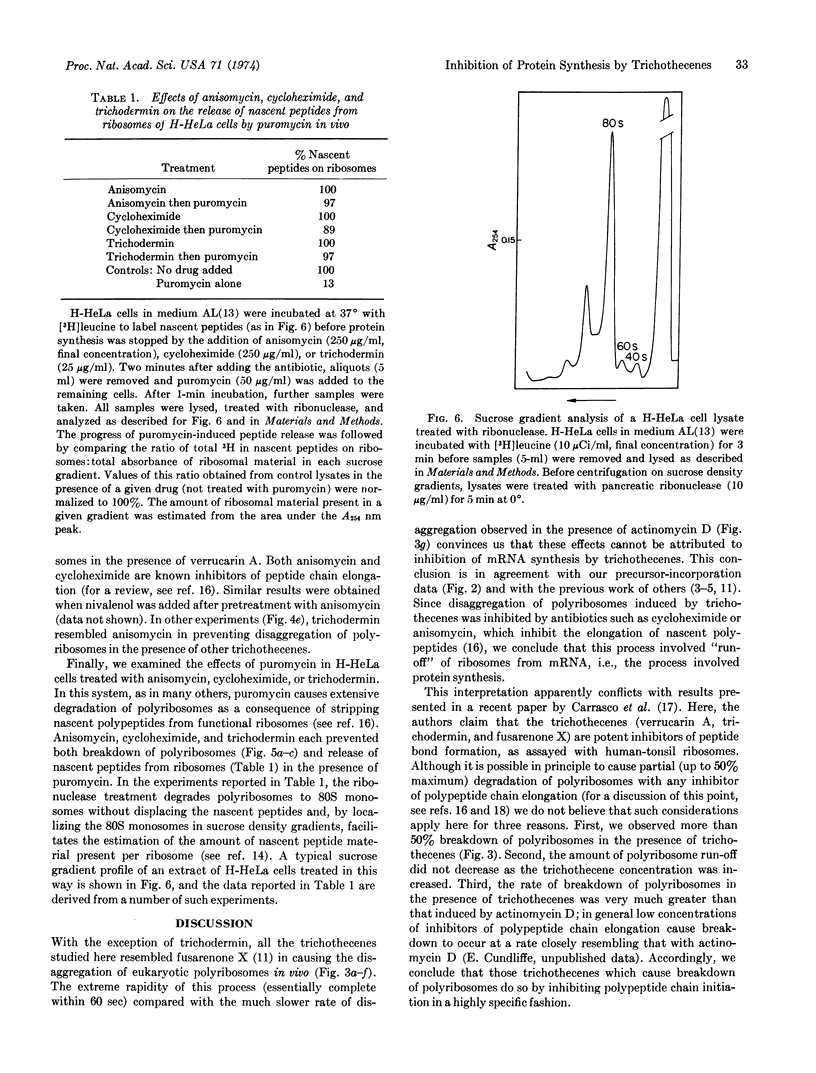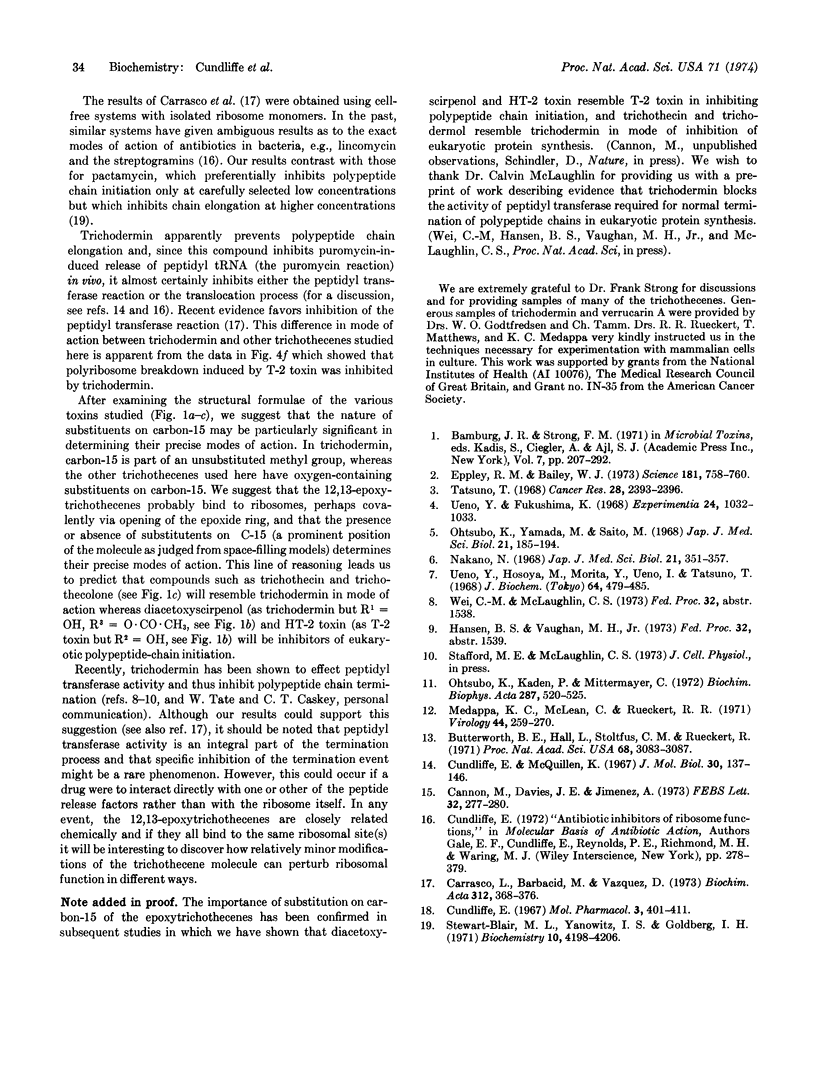Abstract
The 12,13-epoxytrichothecenes, a group of sesquiterpenoid fungal antibiotics, inhibit protein synthesis in eukaryotic cells but do not share a common mode of action. Trichodermin stabilizes polyribosomes, prevents their disaggregation by puromycin, and also prevents the release of nascent peptides from ribosomes by puromycin. Nivalenol, T-2 toxin, and verrucarin A cause rapid and almost quantitative breakdown of polyribosomes in H-HeLa cells, a process which is inhibited by anisomycin, cycloheximide, or trichodermin. Similar effects of trichodermin, nivalenol, and verrucarin A are also observed in yeast spheroplasts. We conclude that nivalenol, T-2 toxin, and verrucarin A are potent and highly selective inhibitors of polypeptide chain initiation in eukaryotes, whereas trichodermin inhibits chain elongation and (or) termination. We have compared the structural formulae of various trichothecenes and suggest that the presence of substituents on carbon-15 of the common trichothecene ring may be important in determining the precise modes of action of this group of compounds.
Keywords: H-HeLa cells, yeast, polyribosomes, peptidyl transferase activity, initiation
Full text
PDF




Selected References
These references are in PubMed. This may not be the complete list of references from this article.
- Butterworth B. E., Hall L., Stoltzfus C. M., Rueckert R. R. Virus-specific proteins synthesized in encephalomyocarditis virus-infected HeLa cells. Proc Natl Acad Sci U S A. 1971 Dec;68(12):3083–3087. doi: 10.1073/pnas.68.12.3083. [DOI] [PMC free article] [PubMed] [Google Scholar]
- Cannon M., Davies J. E., Jimenez A. Inhibition by lomofungin of nucleic acid and protein synthesis in Saccharomyces cerevisiae. FEBS Lett. 1973 Jun 1;32(2):277–280. doi: 10.1016/0014-5793(73)80852-x. [DOI] [PubMed] [Google Scholar]
- Carrasco L., Barbacid M., Vazquez D. The trichodermin group of antibiotics, inhibitors of peptide bond formation by eukaryotic ribosomes. Biochim Biophys Acta. 1973 Jun 23;312(2):368–376. doi: 10.1016/0005-2787(73)90381-x. [DOI] [PubMed] [Google Scholar]
- Cundliffe E. Antibiotics and polyribosomes. Chlortetracycline and polyribosomes of Bacillus megaterium. Mol Pharmacol. 1967 Sep;3(5):401–411. [PubMed] [Google Scholar]
- Cundliffe E., McQuillen K. Bacterial protein synthesis: the effects of antibiotics. J Mol Biol. 1967 Nov 28;30(1):137–146. doi: 10.1016/0022-2836(67)90249-5. [DOI] [PubMed] [Google Scholar]
- Eppley R. M., Bailey W. J. 12,13-Epoxy-delta 9-trichothecenes as the probable mycotoxins responsible for stachybotryotoxicosis. Science. 1973 Aug 24;181(4101):758–760. doi: 10.1126/science.181.4101.758. [DOI] [PubMed] [Google Scholar]
- Medappa K. C., McLean C., Rueckert R. R. On the structure of rhinovirus 1A. Virology. 1971 May;44(2):259–270. doi: 10.1016/0042-6822(71)90258-3. [DOI] [PubMed] [Google Scholar]
- Nakano N. Inhibitory effects of fusarenon on multiplication of Tetrahymena pyriformis. Jpn J Med Sci Biol. 1968 Oct;21(5):351–357. doi: 10.7883/yoken1952.21.351. [DOI] [PubMed] [Google Scholar]
- Ohtsubo K., Yamada M., Saito M. Inhibitory effect of nivalenol, a toxic metabolite of Fusarium nivale, on the growth cycle and biopolymer synthesis of HeLa cells. Jpn J Med Sci Biol. 1968 Jun;21(3):185–194. doi: 10.7883/yoken1952.21.185. [DOI] [PubMed] [Google Scholar]
- Otsubo K., Kaden P., Mittermayer C. Polyribosomal breakdown in mouse fibroblasts (L-cells) by Fusarenon-X, a toxic principle isolated from Fusarium nivale. Biochim Biophys Acta. 1972 Dec 22;287(3):520–525. doi: 10.1016/0005-2787(72)90297-3. [DOI] [PubMed] [Google Scholar]
- Stewart-Blair M. L., Yanowitz I. S., Goldberg I. H. Inhibition of synthesis of new globin chains in reticulocyte lysates by pactamycin. Biochemistry. 1971 Nov;10(23):4198–4206. doi: 10.1021/bi00799a007. [DOI] [PubMed] [Google Scholar]
- Tatsuno T. Toxicologic research on substances fro Fusarium nivale. Cancer Res. 1968 Nov;28(11):2393–2396. [PubMed] [Google Scholar]
- Ueno Y., Fukushima K. Inhibition of protein and DNA syntheses in Ehrlich ascites tumour by nivalenol, a toxic principle of Fusarium nivale-growing rice. Experientia. 1968 Oct 15;24(10):1032–1033. doi: 10.1007/BF02138729. [DOI] [PubMed] [Google Scholar]
- Ueno Y., Hosoya M., Morita Y., Ueno I., Tatsuno T. Inhibition of the protein synthesis in rabbit reticulocyte by Nivalenol, a toxic principle isolated from Fusarium nivale-growing rice. J Biochem. 1968 Oct;64(4):479–485. doi: 10.1093/oxfordjournals.jbchem.a128919. [DOI] [PubMed] [Google Scholar]


